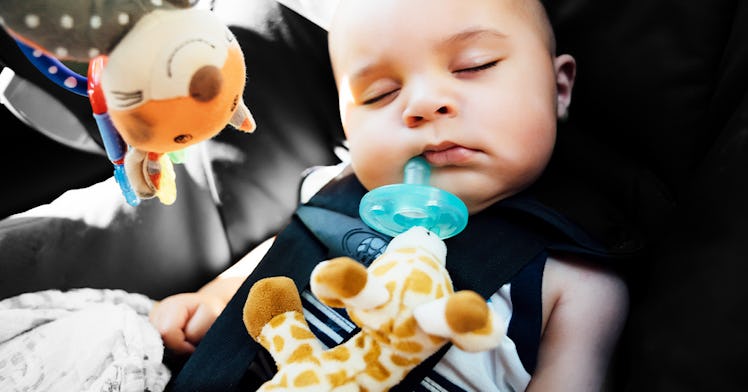How Car Seat Accessories Make Car Seats Less Safe
Those car seat head supports, toys, and mirrors might keep small passengers quiet and entertained, but in the event of a crash, they could be deadly.

Car seats save lives. There’s no one really arguing with that. But how we use them makes all the difference. The Centers for Disease Control and Prevention estimate that car seats reduce the risk of kids getting injured in car crashes by as much as 82 percent, but that “59 percent of car seats and 20 percent of booster seats are misused in a way that could reduce their effectiveness.” While many parents are conscious of car seat safety and the importance of correct installation, a common but overlooked source of danger lies in car seat accessories. Those car seat mirrors, toys, head supports, seat protectors, and other accessories might keep small passengers comfortable and quiet momentarily, but in a crash, they could be deadly.
“There’s a lot of things that get put on the market that we know are dangerous and we know will make car seats work less effectively, but they still get marketed and they still get sold,” says Dr. Benjamin Hoffman, chair of the American Academy of Pediatrics Council on Injury, Violence and Poison Prevention. “The priorities are not around the demonstration of safety and efficacy, the priorities around getting things out into the market, and then waiting and waiting to see what happens.”
Items that come with a car seat, or are approved for use with a specific car seat model, have been tested with it, and are safe, according to Car Seats for Littles (CSFL), a nonprofit staffed by certified child passenger safety technicians. (Technicians pass a nationally standardized course, and the certification program is a partner of the National Highway Traffic Safety Association and The National Child Passenger Safety Board.) But car seat accessories sold separately, sometimes called third-party or aftermarket items, don’t have evidence-based safety standards. Since there are no federal safety regulations concerning the safety of car seat accessories, even items labeled ‘crash-tested,’ haven’t undergone standardized testing, so it’s anyone’s guess how they’ll act in a crash. Manufacturers might even claim items meet safety standards, despite there being no standards that apply to them. “If it did not come as original equipment in the box with the car safety seat, it is probably not ok to use,” Hoffman says. “If there is ever any question, calling the car safety seat manufacturer is the right thing to do.”
Anything that’s not secured to the car could become a projectile in the event of a crash, according to Car Seats for Littles, making items like back seat mirrors, with their potential to break and hit passengers, extra dangerous. Objects in motion stay in motion, and when a car comes to a sudden stop, the speed at which loose objects travel makes their force feel heavier on impact. One study published in the Journal of the American Medical Association, people wearing seat belts were significantly more likely to die in car accidents in which other passengers were unrestrained, as their bodies became projectiles. But even smaller objects pose serious risks. In 2018, a 3-year-old girl in Spain died after a car accident in which her tablet collided with her head.
Accessories that go directly in or on a car seat, like head supports or pillows, strap covers, car seat protectors, seat belt tighteners, or tools marketed to make the car seat installation easier, are particularly dangerous because “they fundamentally change the way the child fits in the seat,” Hoffman says. In the worst cases, they make the car seat ineffective.
One Georgia mom’s post went viral back in 2018 when she shared that her use of strap covers caused her 3-month-old daughter to be ejected from her car seat during a crash. Though her daughter was buckled securely, a car seat expert at her doctor’s office said the force of the accident caused the straps to slide against her shirt and free her from restraint.
As an alternative to strap covers, which are meant to prevent straps from irritating a child, CSFL recommends simply pulling a kid’s shirt up higher to create a barrier between the strap and a child’s skin. If a newborn really needs additional head support, CSFL recommended rolling up two receiving blankets and placing them on either side of an infant’s head. This shouldn’t be necessary as most car seats come with infant inserts, but talk to your pediatrician if you’re concerned.
Car seat protectors, which go between a car seat and the actual seat of the car, are often made of grippy material, which could make a car seat appear secure and camouflage imperfect installment. Real damage to your seat is unlikely. Indentations in the seat will reverse themselves in time, and if it’s your kid making a mess you’re worried about, limiting snacks in the car is a better option than reducing the effectiveness of their car seat. Just skip these.
Another thing to note, though admittedly less important than safety, is that anything not approved for use by a car seats manufacturer could void the warranty. Meaning that if you use a third party toy and it causes damage or decreased effectiveness, the car seat company is off the hook. To be safe, parents should use only what comes with a carseat, and make sure any items they’re bringing in the car are secured.
“Do your best, read the manufacturer’s instructions, and find a certified child passenger safety technician in your community who can help you learn how to use it correctly,” Hoffman says. Parents can find a car seat technician to review their car seat installation through the National Child Passenger Safety Certification program or the National Highway Traffic Safety Administration. Parents should also consider registering their car seat with the NHTSA to receive updates on recalls.